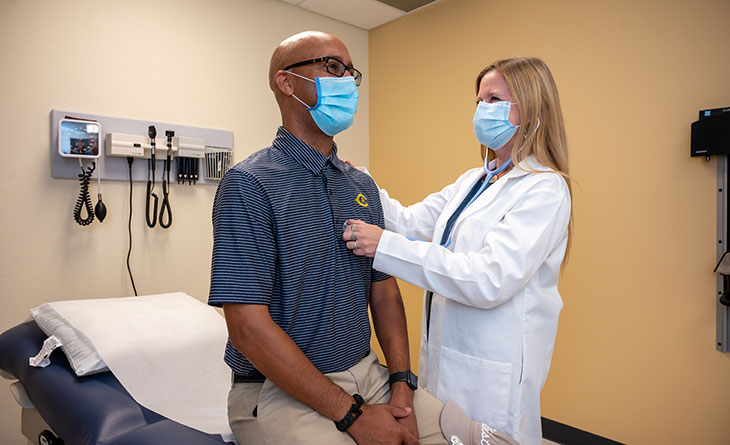Understanding the Important Role of Medical Care in Comprehensive Health Monitoring and Illness Prevention Approaches
The essential function of main care in extensive health and wellness administration and illness prevention techniques can not be overstated, as it serves as the structure for reliable medical care distribution. By focusing on precautionary care and fostering enduring patient-provider connections, primary treatment practitioners are distinctly positioned to resolve specific health requirements while likewise influencing more comprehensive neighborhood health and wellness outcomes.
Interpretation of Health Care
Although the idea of main care might vary throughout various healthcare systems, it fundamentally describes the initial factor of contact for patients within the medical care continuum. Health care includes a broad variety of services, including preventative care, medical diagnosis, treatment, and monitoring of chronic problems. It is defined by its extensive, obtainable, and coordinated method, making sure patients obtain holistic care customized to their private needs.
Health care companies, usually household medical professionals, internists, or pediatricians, play a vital role in establishing ongoing patient-provider partnerships. This connection of care fosters count on and promotes better health and wellness end results through normal monitoring and customized treatments. The focus on a patient-centered approach permits the factor to consider of social, financial, and psychological factors that affect wellness.
Furthermore, medical care acts as an essential component in navigating the health care system, leading patients through specialized services when required. By working as a main center for wellness monitoring, medical care not just addresses prompt clinical concerns however likewise highlights the relevance of overall wellness and safety nets. Thus, its definition extends beyond simple therapy to include a detailed structure for health promo and disease prevention.
Benefits of Preventive Treatment
Preventive care offers numerous benefits that substantially boost private and community health outcomes. By concentrating on the prevention of diseases and wellness issues before they occur, preventive care lowers the incidence of severe wellness problems, consequently decreasing healthcare costs with time. Early discovery through normal screenings and analyses enables timely treatments, which can stop the progression of illness, causing enhanced lifestyle for people.
Moreover, preventative treatment advertises health and wellness education and awareness, encouraging individuals to make educated choices regarding their way of livings and health and wellness actions. This positive strategy encourages routine check-ups, vaccinations, and wellness screenings, which not just benefit individuals but likewise add to the overall health of the neighborhood. By lowering the concern of persistent diseases and preventing break outs of transmittable diseases, preventive care plays an essential function in boosting public health.
In enhancement to boosting specific health outcomes, precautionary treatment cultivates an extra efficient health care system by reducing the need for substantial therapies and hospital stays. Inevitably, buying preventative treatment is essential, as it helps with much healthier populaces, lowers wellness variations, and makes certain far better source allowance within the healthcare system.
Role in Chronic Disease Management
The proactive methods utilized in precautionary treatment contribute in the management of chronic diseases, which often require recurring interest and resources. Primary treatment carriers play a critical role in this context, working as the initial point of contact for people with persistent conditions such as diabetes, high blood pressure, and heart condition. They are crucial in creating personalized management strategies that include regular surveillance, medication management, and lifestyle alterations.

Moreover, health care service providers usually use modern technology and data analytics to track patient development and determine prospective problems early. This proactive tracking boosts individual engagement and encourages individuals to take an active duty in their health administration. Inevitably, the assimilation of primary treatment right into chronic condition management fosters enhanced top quality of life and reduces the concern on health care systems.
Patient-Provider Relationships

Additionally, a durable patient-provider relationship enhances person engagement and self-management. Suppliers that spend time in understanding their clients' backgrounds, choices, and inspirations are much better outfitted to sustain them in handling their conditions. This tailored approach can lead to improved health outcomes, as clients are a lot more most likely to adhere to referrals when they really feel valued and Our site understood.
Furthermore, continuity of treatment plays a significant role in strengthening these partnerships. Normal communications in between clients and suppliers facilitate ongoing assessment and changes to therapy plans, which is essential for taking care of persistent illness effectively. This connection not just promotes much better health and wellness outcomes yet additionally minimizes healthcare expenses by reducing the demand for immediate interventions.
Impact on Community Health
Solid patient-provider relationships significantly affect community health and wellness outcomes, as they add to a more involved and notified populace. rhino virus. When people feel linked to their health care providers, they are more probable to seek precautionary services, comply with treatment plans, and take part in health-promoting behaviors. This involvement cultivates a culture of wellness, where people prioritize their wellness and the well-being of their neighborhood
Additionally, efficient communication between patients and providers enhances wellness proficiency, equipping individuals to make educated decisions regarding their treatment. This boosted understanding can result in decreased prices of persistent illness, as patients come to be positive in managing their health. Furthermore, strong relationships promote the recognition of community-specific health and wellness challenges, making it possible for companies to tailor treatments that attend to local demands.
Furthermore, key care functions as an important gain access to factor for health and wellness sources, linking patients with essential services and assistance networks. This comprehensive strategy not only enhances specific health and wellness but additionally strengthens neighborhood communication, as locals function collaboratively to address health and wellness differences. In general, the influence of robust patient-provider connections expands beyond the facility, promoting much healthier areas and contributing to a sustainable healthcare system.
Conclusion
In planned parenthood abortion cost summary, key treatment is basic to efficient health and wellness administration and disease prevention - primary care provider pcp near me. Eventually, the integration of primary treatment into community wellness approaches leads to enhanced health pop over here end results and lowered health care costs, emphasizing its crucial role in advertising general community health.